Ancient Roman and Greek Coins, FAQ
Answers to Frequently Asked Questions about Ancient Coins.
This page is mostly for beginning collectors.
What's new? 2023, Dec. 4. The format of this first page was changed.
About buying. About selling. About eBay and other auctions. About rarity and the differences between collecting US and ancient coins. There are also numerous pages on the coins of particular emperors and particular collecting themes (links at the Table of Contents page). If you get interested, there is a page on "What should I collect?" (The answer is, "Anything you like!")
Are there really coins from ancient Greece and Rome? Yes, ancient coins are not just in European museums, but readily available and collectible. Anything ancient that you have heard about--say a place (like Athens) or a ruler (like the Greek king Alexander the Great or the Roman emperor Constantine the Great)--has associated collectible coins.
Here are the two most famous and common Greek coin types (Click the images to enlarge them):
Greek coins
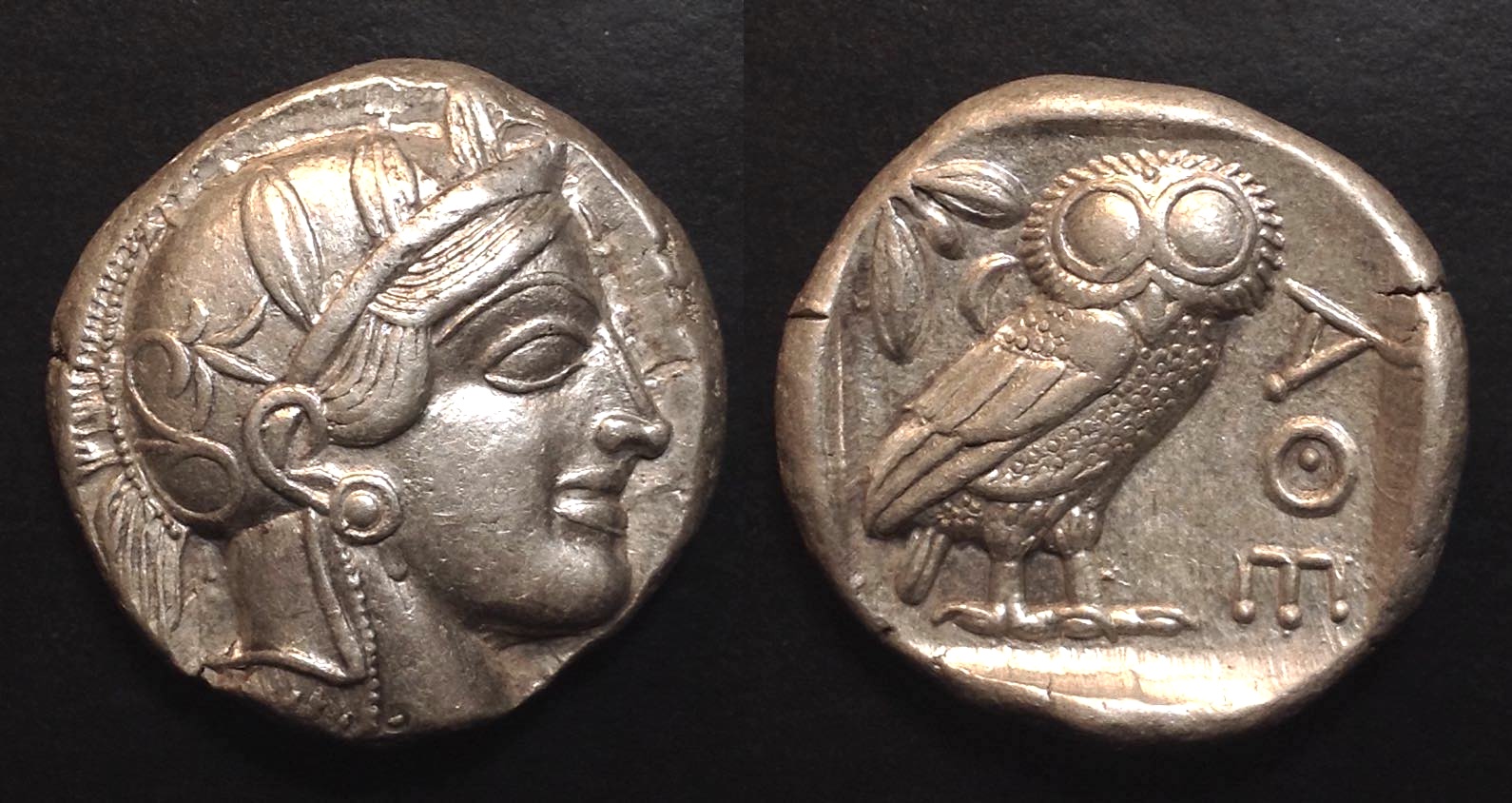 |
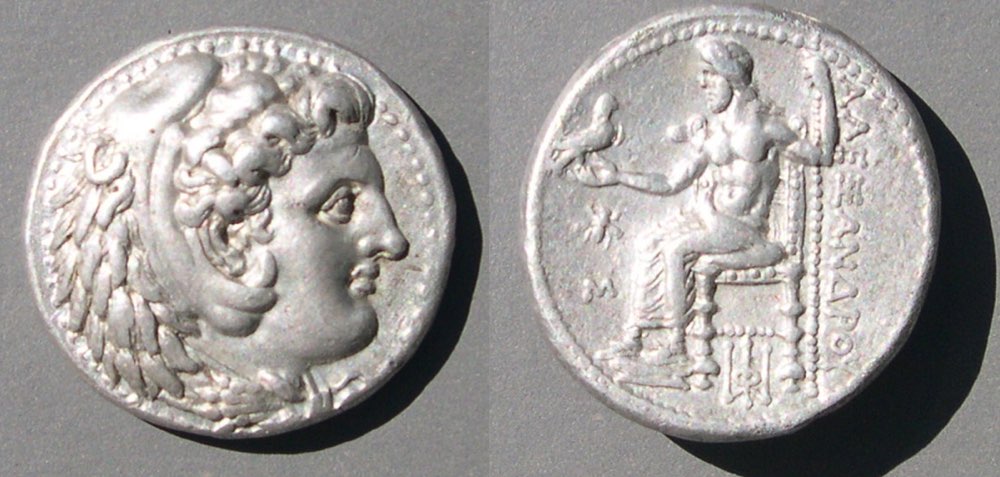 |
Classical Athens, c. 440-404 BC. 24-23 mm. 17.19 grams of silver. (Almost the diameter of a US quarter and three times as thick.) Helmeted head of the goddess Athena right/her owl standing right, looking at you. AΘE for "Athens" to the right.
This was the most important currency of the ancient world in the late fifth century BC. |
Alexander the Great, struck during his lifetime, 336-323 BC, at Babylon, where he died. 27-25 mm. 17.11 grams of silver. (Larger than a US quarter and three times as thick.)
The head of Hercules right, in a lion skin headdress (The jaw opens around his ear and the lion's mane flows at the back of the head)/
The king of the gods, Zeus is seated left holding his eagle and a long scepter. AΛEΞΑNΔPOY ("of Alexander" in Greek) |
| A common chunky silver "tetradrachm" (four drachm piece) commonly called an "owl" because of its reverse. |
A tetradrachm often called an "Alexander." Alexanders come in over a thousand minor varieties, basically like this but with different marks in the field which allow us to assign them to particular mints across his empire. |
The two coins above are the largest common Greek denominations and in outstanding condition so they cost (only) hundreds of dollars. But there are similar smaller coins that cost much less. Drachms of Alexander are one-fourth the weight of the Alexander coin above and inexpensive (under $100 or even under $50). Also, coins of Alexander and many other Greek rulers and many Greek cities come in copper or bronze denominations in good condition for as low as $20 (and even less if you don't mind more wear). Who would have thought you can buy nice coins 2000 years old for $20!
What about Roman coins? Roman coins are common. They were issued from 200 BC to 500 AD (after which they remain common but are renamed "Byzantine" coins).
Roman coins
 |
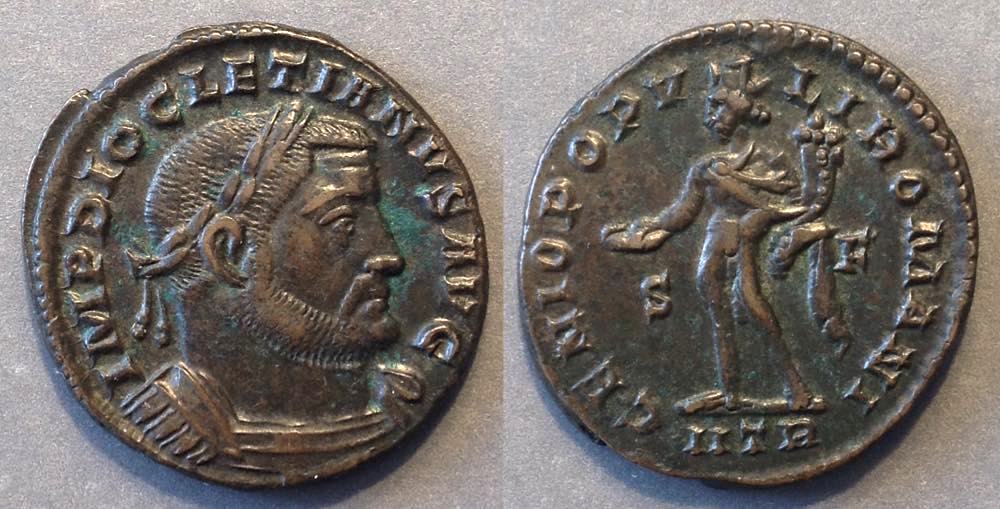 |
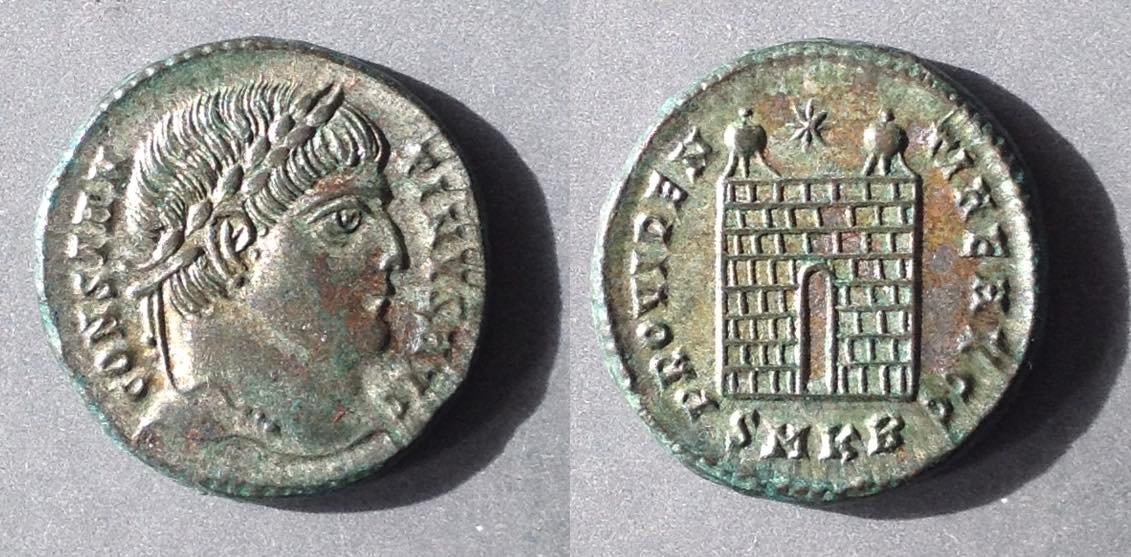 |
| Trajan. 98-117. Silver denarius. 20-18 mm. Trajan issued many types of denarii. The size of a US cent, but in silver. |
Diocletian, 284-305. Follis. 27-26 mm (larger than a US quarter). Issued at the mint of Trier (The mintmark says II TR). |
Constantine the Great, 307-337. "AE3" 19 mm. (The size of a US cent). Copper with a thin cover of silver. |
Trajan was emperor at the empire's greatest extent in 117 AD at the end of his war with Parthia (Persia).
IMP TRAIANO [Trajan] AVG GER DAC PM TRP COS VI PP (These titles allow us to date the coin.)
The reverse declares him
SPQR OPTIMO PRINCIPI
"The Senate and People of Rome, Best Prince" and depicts the famous "Trajan's column" which still stands in Rome. He issued many historical types. |
Diocletian reoganized the empire to have four simultaneous rulers (the "tetrarchy").
IMP DIOCLETIANVS AVG
"Imperator Diocletian Augustus"
Diocletian reorganized the coinage by introducting new denominations, including this very common type:
GENIO POPVLI ROMANI
"Spirit of the Roman people"
Genius (Spirit) is standing left holding out a patera (a shallow dish for sacrifices) and a cornucopia (indicating abundance). |
Constantine coverted the Roman empire from paganism to Christianity. Therefore, he is extremely important in the history of the world.
CONSTANTINVS AVG
"Constantine, Augustus [emperor]"
His diademed head right.
A city gate ("camp gate") with
PROVIDENTIA AVGG
"Foresight of the emperors" around and the mintmark of the mint Cyzicus below.
|
(This page is educational and the coins are not for sale. If you would rather look at coins to possibly buy, see here for links to dealers.)
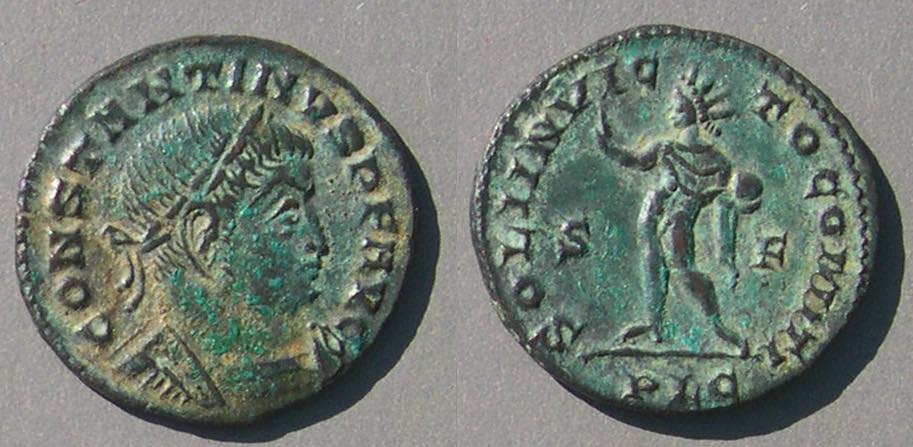
This is a very common copper (copper can turn green with age) coin, 23 mm in diameter (between the sizes of a US nickel and quarter) of the Roman emperor Constantine the Great, who reigned 307 - 337 A.D, over 1600 years ago. For more commentary, click the image.
Are there really genuine ancient coins?
Oh, yes. The Greeks and Romans minted huge numbers of coins and many millions (really!) are still around in nice shape.
How old are they?
The Greeks minted coins beginning about 600 years before the time of Christ. The most common ancient coins are Roman coins minted in the third and fourth centuries AD (200 AD to 400 AD), so most ancient coins are 1600 years old or older, and many are over 2000 years old.
What do they look like?
The next one is a common Roman silver coin denomination, a denarius, the size of a US cent.

Roman emperor Septimius Severus, 193-211 A.D.
The legend (beginning at 6:30 on the obverse) gives his name "SEVERUS".
For the reverse and commentary, click the image.
To learn about reading legends, go to a page on legends.
Next is a Greek silver coin which depicts the head of one of the Seven Wonder of the Ancient World, the "Colossus of Rhodes."
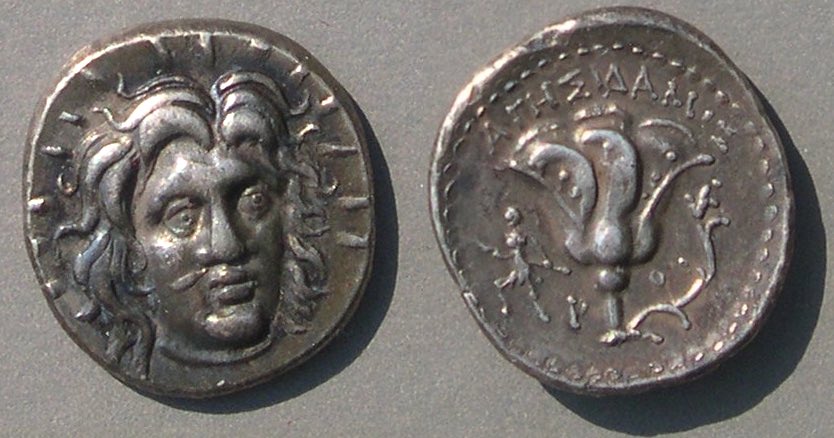 A coin struck for the city of Rhodes (on an island just off the southwest coast of modern Turkey) 250-230 BC.
A coin struck for the city of Rhodes (on an island just off the southwest coast of modern Turkey) 250-230 BC.
A silver didrachm (2-drachm piece). 21 mm, the diameter of a US nickel, but twice as thick.
The obverse shows the sun god, Helios. Do you see the sun's rays streaming from his head?
The reverse shows a rose, the symbol of Rhodes, because of the pun Rhodes/rose.
The letters, in Greek, name the person (not a king) responsible for minting the coin.
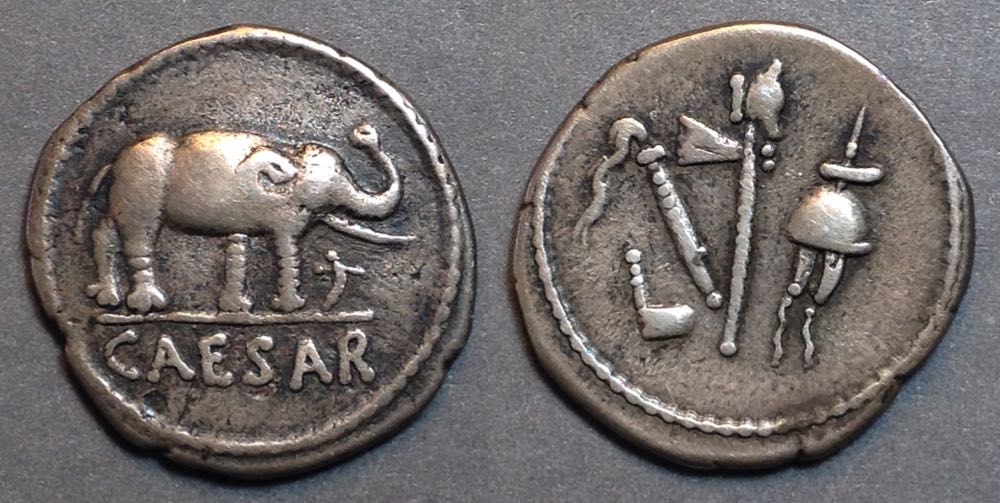 Roman Republican silver denarius struck by Julius Caesar in 49-48 BC,
Roman Republican silver denarius struck by Julius Caesar in 49-48 BC,
19 mm. 3.18 grams [The size of a US ccent]
Elephant standing right, trampling serpent
Four attributes of the High Priest (Julius Caesar was Pontifex Maximus, high priest)
Lituus (cup with a handle for pouring libations), sprinkler (for spattering holy liquid over worshippers), an ax (symbol of power), and an apex (a priest's pointed hat with cheek guards and ties).
Roman Republican denarii have many different designs and are very collectible.
Show me more!
Gladly. There's lots more interesting stuff!
Continue on page 2:
Why are there so many genuine ancient coins? Photos, designs, legends, ancient value,
modern costs, dealers. What do people collect?
Skip to page 3: books, ancient coin websites, Julius Caesar,
Alexander the Great, inexpensive coins, women on coins,
grading, fakes, buying, proper prices, selling,
e-mail list, eBay buying and selling, how coin auctions work,
moving beyond the "beginner" level, educational links, and more!
Material about buying and selling.
Material about moving up to "intermediate" from "beginner" and Roman coin educational links.
Return to the Table of Contents of this whole group of pages.
Originally posted 2/13/97. Revised, June 22, 2013. Revised Sept. 19, 2018. Revised June 5, 2023. Revised Dec. 4, 2023.








